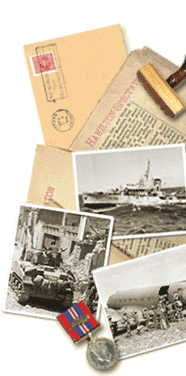 
This collection of more than 140,000 clippings, arranged by subject and date, includes news stories and editorials from newspapers, mostly Canadian, documenting every aspect of the war. The English-language clippings are from the archive of the century-old Hamilton Spectator newspaper, while the French-language materials are from a collection of the newspaper Le Devoir.
You are invited to explore the online database using either the Basic search or the detailed
search, which includes a date searching feature. Short historical articles on key topics from the time period, along with sample clippings from the collection, supplement this impressive resource of news information "as it happened". A glossary of terms, highlighted in red throughout the historical articles, provides definitions for technical terms and abbreviations.
The Second World War
Fought on every continent except Antarctica, in all the oceans, and through the vast distances of the world's airspace, the Second World War was the most significant person-made event in human history. It shattered millions of lives and shaped the world for decades to come. Its effects are felt still.
An estimated fifty million people, both combatants and civilians, died in battle or by execution, disease or starvation. The young did most of the fighting. Those who survived often carried with them disabilities, wounds and emotional illness, and their lives were frequently shorter and always distorted by what they had experienced. The war also caused irreparable damage to the natural environment and to the world's collective cultural heritage.
The detonation of two atomic bombs in Japan at war's end brought a glimpse of the terror of nuclear war. The world would have to live with weapons that had the potential to kill millions in moments and indeed to kill the whole human race. That prospect was increased when a Cold War rose out of the Second World War, and pitted the Communist Soviet Union, suspicious of the West and intent on protecting itself from further attacks on its soil, against democratic capitalist countries such as the United States and Canada.
The Second World War led to technological innovations such as synthetic rubber, the computer, affordable trans-Atlantic aviation, plastics and synthetic fibres, radar and the jeep. Memories of the Depression of the 1930s and the war which was in many ways its child were an impetus to the building of social welfare states in Canada, Britain and elsewhere after 1945. The United Nations was a further attempt to turn the war in the direction of constructive change, an imperfect but deliberate effort to build a system of international co-operation where possible and a method of deterrence when peace failed.
Related Newspaper Articles
|